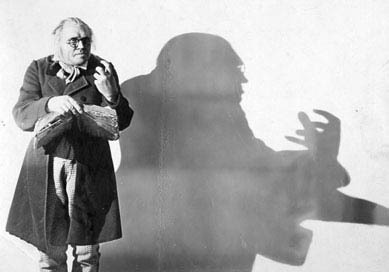The Cabinet of Dr Caligari + Live Organ Accompaniment
Dir. Robert Wiene, 1920
-
Sun 13 November 2011 // 19:30
/ Cinema
The Cabinet of Dr Caligari was truly one of the pioneering films of early cinema, bringing together a fantastic cast to inhabit a twisted, surreal world of shadow and light. Arguably the first true horror movie, Caligari proved to be influential way beyond the sum of its parts.
+ LIVE ORGAN!
This fabulous film will be accompanied by the great Carl Heslop playing on the Compton cinema organ!
THE PLOT
Doctor Caligari is an expert on the new science of mesmerism, and his sleepwalking subject, Cesare, is a predictor of future events. When a visitor to Caligari's exhibition is murdered, the police investigate the mysterious doctor, leading to a shocking conclusion.
A HIT?
When famed director Fritz Lang passed on the script, leaving the less known Robert Wiene to take the helm, little was expected of this creepy tale, and still it became a classic of the experimental expressionist movement. So what made Dr Caligari such a hit?
Word of mouth had already begun to spread with its mysterious poster campaign, "You Have To Become Caligari!", and filmgoers were not let down with its stunning visuals and creepy characters.
It was one of the first films to frame a story in flashback, crediting viewers with an intelligent story, and not only that, it was also one of the first to bring a postmodern flourish to popular cinema, with its twist ending that no one could have expected. To call it influential is truly an understatement: without Caligari, there'd be no Usual Suspects, and certainly no Shutter Island.
CASTING
Casting the already-popular Conrad Veidt was a masterstroke too – the imposing German brought a lustrous intensity to his role as Cesare, and paved the way for his future successes, from the Hands of Orlac to the Maltese Falcon. Ironically, for an actor who played Nazis so well, Veidt was a staunch anti-fascist, declaring himself Jewish on census forms as an act of protest against the political climate in his home country.
Werner Krauss, as the mad doctor, is also worthy of note. He plays the ageing, and insane, Doctor C. convincingly, despite being only in his early 30's – a testament to the pioneering make-up effects throughout. Krauss delights in the role of the madman, bringing life to what could easily have been a lot of scenery-chewing.
At the time, doctors were pretty much beyond reproach, and to have an insane doctor as a central character was risky. The Establishment was not going to like having one of their own portrayed in the throes of insanity – and yet it worked. Krauss's performance was insane, but it was still based in humanity.

STUNNING VISUALS
Visually, the film is stunning beyond measure. Shadows are painted thick on the walls, and tricks of perspective constantly challenge the reality of the character's world. Expressionism had a new flagship, and thus began the melding of art and storytelling that created a new world of cinema, influential beyond its means.
REAL STORY?
As a curious footnote, the story of Dr Caligari apparently came about through real events. Writer Hans Janowitz visited a carnival and repeatedly witnessed a spooky, shadowy figure on its fringes, avoiding the crowds. The next day, a young girl was found murdered, and guess who Janowitz saw at the back of her funeral, avoiding the gaze of the mourners…?
Price: £5 (full price) / £3.50 (concessions)
Or £4.50 online - http://www.wegottickets.com/event/135308
